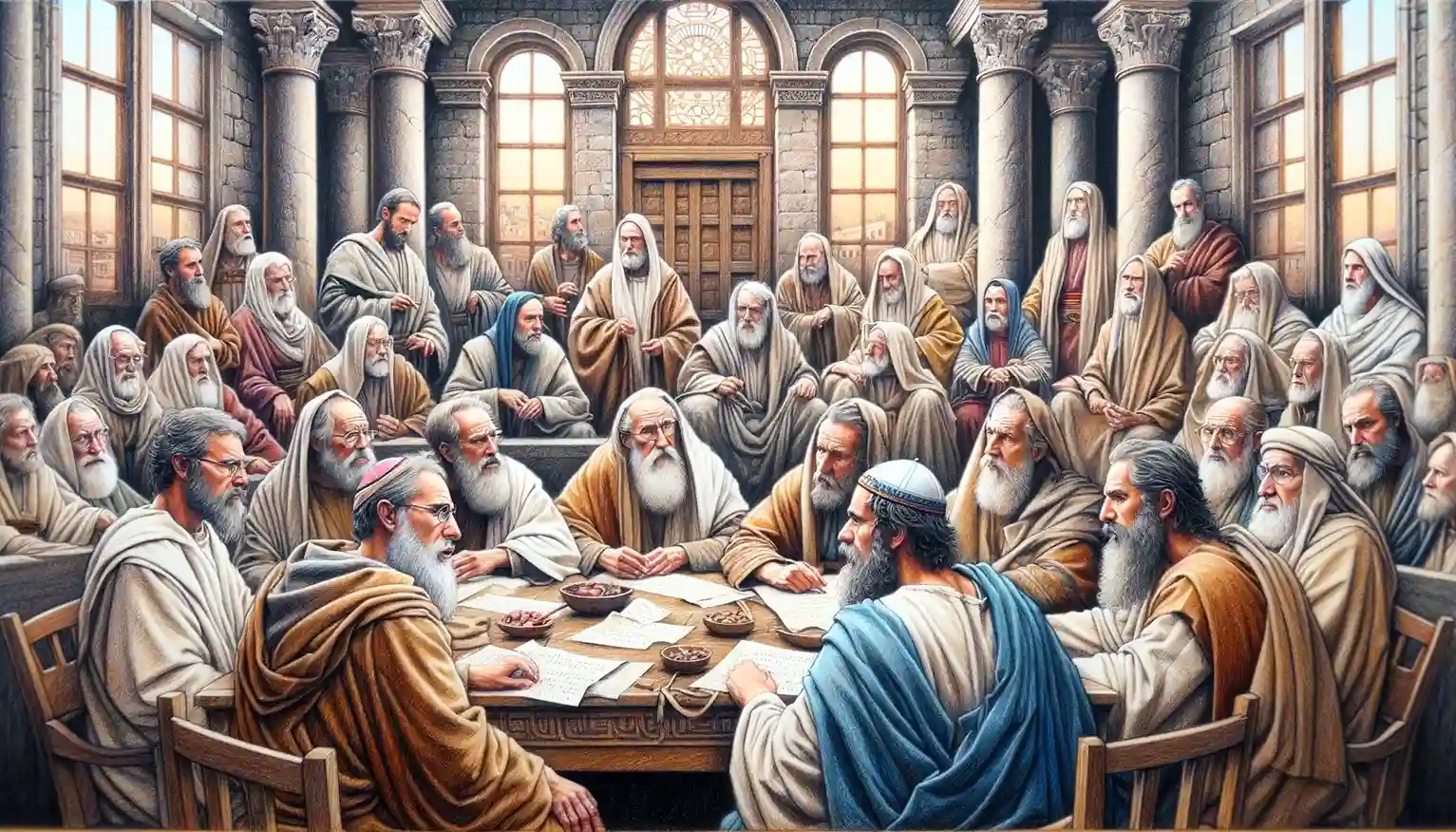
The Council of Jerusalem
The Council of Jerusalem, as recounted in Acts 15:1-35, was a significant assembly of the early Christian leaders in Jerusalem. The council addressed critical issues concerning Gentile converts to Christianity and the requirements for their inclusion in the Church, particularly focusing on whether they needed to adhere to Jewish laws.
Quick Facts:
- Controversy over Circumcision: The council was convened because certain Jewish Christians from Judea were teaching that Gentile converts must be circumcised according to the Law of Moses to be saved (Acts 15:1).
- Paul and Barnabas: Paul and Barnabas, who had been preaching to the Gentiles, were sent to Jerusalem to discuss this issue with the apostles and elders (Acts 15:2).
- Peter’s Speech: Peter addressed the council, recounting how God had chosen him to preach to the Gentiles and how the Holy Spirit had been given to them without the need for circumcision (Acts 15:7-11).
- James’ Judgment: James, the leader of the Jerusalem church, supported Peter’s argument, citing Scripture and proposing that Gentile converts should not be burdened with the full yoke of Jewish law (Acts 15:13-21).
- The Apostolic Letter: The council decided to send a letter to the Gentile believers in Antioch, Syria, and Cilicia, stating that they should abstain from things polluted by idols, sexual immorality, meat of strangled animals, and blood, but they did not need to be circumcised (Acts 15:23-29).
- Delegates Sent: The council sent Judas (called Barsabbas) and Silas, along with Paul and Barnabas, to deliver the letter and affirm its decisions (Acts 15:22).
- Rejoicing in Antioch: The Gentile believers in Antioch received the letter with joy and encouragement, as it confirmed their inclusion in the Christian community without the requirement of circumcision (Acts 15:30-31).
Context and Background: The Council of Jerusalem, recorded in Acts 15:1-35, is a pivotal event in the history of the early Christian church. This council was convened to address a critical theological and cultural issue: the requirements for Gentile converts to Christianity, particularly regarding adherence to Jewish laws such as circumcision. The resolution of this issue was essential for the unity and growth of the early Church.
1. The Controversy: The controversy arose because certain Jewish Christians from Judea insisted that Gentile converts must be circumcised and follow the Mosaic Law to be saved (Acts 15:1). This teaching created significant tension, especially in Antioch, where many Gentiles had embraced Christianity without adopting Jewish customs. Paul and Barnabas strongly opposed this view, prompting the need for a definitive resolution from the church leadership in Jerusalem (Acts 15:2).
2. The Delegation to Jerusalem: Paul and Barnabas, along with some others, were appointed to go to Jerusalem to discuss this issue with the apostles and elders. Their journey underscored the importance of the matter and the necessity of a unified decision from the church’s leadership (Acts 15:2-3).
3. The Council’s Deliberation: Upon arrival, Paul and Barnabas reported the conversion of the Gentiles, which sparked debate among the apostles and elders (Acts 15:4-6). This gathering included prominent leaders like Peter, James, and others, reflecting the seriousness and inclusivity of the council.
4. Peter’s Speech: Peter addressed the assembly, reminding them of his own experience with Cornelius, a Gentile, and how God had given the Holy Spirit to the Gentiles without requiring circumcision (Acts 15:7-9). He argued that God made no distinction between Jews and Gentiles, cleansing their hearts by faith. Peter’s speech emphasized that salvation is through grace, not adherence to the Law (Acts 15:10-11).
5. Paul and Barnabas’ Testimony: Paul and Barnabas shared their experiences among the Gentiles, recounting the signs and wonders God had performed (Acts 15:12). Their testimony provided further evidence that God was working among the Gentiles independently of the Mosaic Law.
6. James’ Judgment: James, the leader of the Jerusalem church, offered a concluding judgment. He cited the prophet Amos, indicating that God’s plan included the Gentiles (Acts 15:13-18). James proposed that Gentiles should not be burdened with circumcision but should abstain from practices particularly offensive to Jewish Christians: food sacrificed to idols, blood, meat of strangled animals, and sexual immorality (Acts 15:19-20). This decision aimed to facilitate fellowship between Jewish and Gentile Christians.
7. The Apostolic Letter: The council drafted a letter to the Gentile believers in Antioch, Syria, and Cilicia, explaining their decision. The letter, delivered by Judas (called Barsabbas) and Silas along with Paul and Barnabas, reassured the Gentiles that circumcision was not required but asked them to follow certain guidelines to maintain harmony (Acts 15:22-29).
8. Reception in Antioch: The letter was received with joy and encouragement by the Gentile believers in Antioch (Acts 15:30-31). This positive reception demonstrated the success of the council’s decision in promoting unity and clarifying the basis of salvation by grace through faith, rather than adherence to the Mosaic Law.
Theological Insights:
1. Salvation by Grace: The council’s decision affirmed that salvation is by grace through faith in Jesus Christ, not by works of the Law. This was a foundational principle for the early Church and a critical theological stance that differentiated Christianity from Judaism.
2. Unity in Diversity: The resolution of the council showcased the early Church’s commitment to unity amid diversity. By not imposing the full burden of the Jewish Law on Gentile converts, the council recognized the diverse backgrounds of believers and sought to foster inclusion and mutual respect.
3. Role of Apostolic Authority: The council highlighted the role of apostolic authority in resolving doctrinal disputes. The involvement of key leaders like Peter, Paul, and James ensured that the decision carried significant weight and helped to maintain the integrity and unity of the Church.
4. Practical Considerations: The guidelines given to the Gentiles were practical measures to promote fellowship between Jewish and Gentile Christians. They were not seen as salvific requirements but as ways to maintain harmony and respect within the diverse Christian community.
Conclusion: The Council of Jerusalem, as detailed in Acts 15:1-35, was a landmark event that shaped the early Church’s understanding of Gentile inclusion and the nature of salvation. By affirming salvation by grace and addressing practical concerns for community harmony, the council set a precedent for addressing theological and cultural issues with wisdom, sensitivity, and a commitment to unity. This event not only resolved a significant controversy but also laid the groundwork for the global mission of the Church, emphasizing the inclusive and transformative message of the Gospel.



